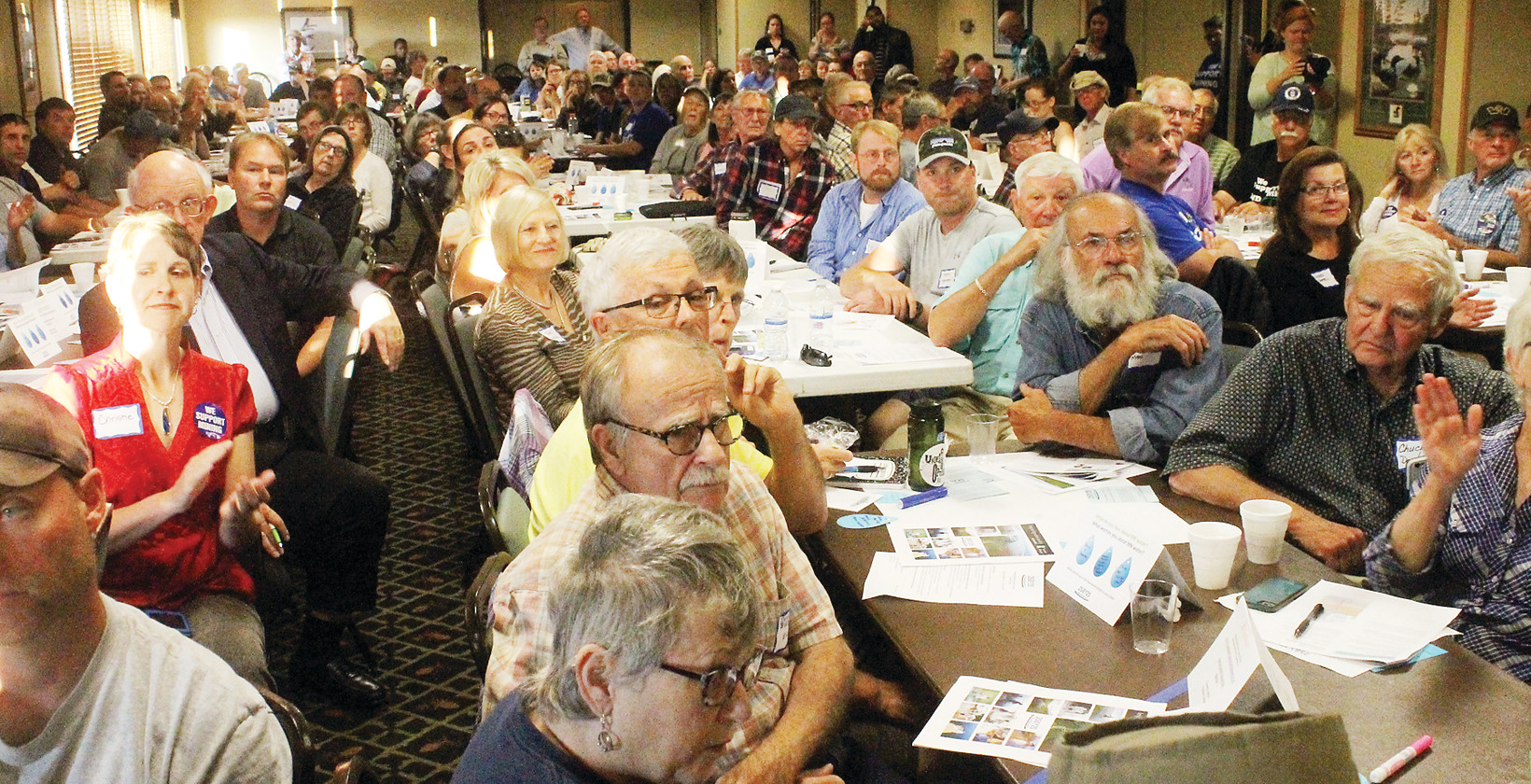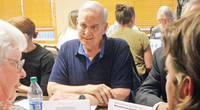Support the Timberjay by making a donation.
Clean water on agenda in Ely
Gov. Dayton hosts town hall to push ‘25 by 25’ goal
ELY – Ely may be at the end of the road and on the edge of some of the state’s most clean and clear waters, but it was a key stop for Gov. Mark Dayton Tuesday night in a series of meetings about …
This item is available in full to subscribers.
Attention subscribers
To continue reading, you will need to either log in to your subscriber account, or purchase a new subscription.
If you are a current print subscriber, you can set up a free website account and connect your subscription to it by clicking here.
If you are a digital subscriber with an active, online-only subscription then you already have an account here. Just reset your password if you've not yet logged in to your account on this new site.
Otherwise, click here to view your options for subscribing.
Please log in to continue |
Clean water on agenda in Ely
Gov. Dayton hosts town hall to push ‘25 by 25’ goal
ELY – Ely may be at the end of the road and on the edge of some of the state’s most clean and clear waters, but it was a key stop for Gov. Mark Dayton Tuesday night in a series of meetings about improving the water quality in Minnesota.
The Water Quality Town Hall sessions were put together, Dayton said, “to hear from Minnesotans about ways to improve the state’s water quality at the local level.” Ely was one of 10 cities across the state selected to host a meeting, part of Dayton’s “25 by 25” Water Quality goal proposal, announced earlier this year.
“This area of the state has really good water quality. You’re in a better situation than most,” Dayton said. “But all the more reason to focus on prevention and protection.”
More than 300 people packed into the Grand Ely Lodge. Some were expecting a debate on mining versus environmental protection. Several mining advocates wore “We Support Mining” T-shirts, hats and buttons, an obvious slam at Dayton who opposes the proposed Twin Metals copper-nickel mine just southeast of Ely. Sulfide mining was obviously not on the agenda.
After opening remarks by Anna Henderson, water advisor to Gov. Dayton, Ely Mayor Chuck Novak introduced the governor. “When I learned about the governor’s ‘25 by 25’ initiative, he said, ‘one size does not fit all’ and that impressed me,” Novak said. “In Ely we don’t have industrial pollution. We don’t have agricultural pollution. We have to put a little salt on the road. We are all passionate about clean water. We don’t want to destroy our water.”
Novak said that Ely’s economy is currently tourism-based. “If we lose our water, we lose our economy. We have to be very serious about this,” he said. He noted that having Ely adhere to water quality and sulfate guidelines like those proposed in industrial and agricultural areas in southern Minnesota, could raise water rates here as much as $24 per customer per month. “That is not acceptable,” he said.
“All Minnesotans have a stake in water that’s safe for drinking, swimming, and fishing,” Dayton said. “These town hall meetings will further the important conversations already happening across Minnesota around water quality. Together we can develop strategies and solutions that work for all of our communities.”
Dayton admitted that water quality in this region is generally very good, with many lakes and streams ranking among the cleanest in the state. Forestland provides source water protection and improves lake and stream water quality through erosion control and stable flows of water. “You are in a better situation than most, but that’s all the more reason to be focused on preserving and protecting the water quality you do enjoy here,” he said.
After brief remarks from Frank Jewell, St. Louis County Commissioner, Charlene Manson, International Rainy-Lake of the Woods Watershed board member, and Dan Schutte, district manager of the Lake County Soil and Water Conservation District, the gathering broke up into small group discussions that focused on developing two or three goals on how to improve and protect Northeastern Minnesota water quality.
Achieving a 25-percent improvement in water quality statewide would require Minnesota to take aggressive, yet achievable, action, according to Dayton. It also would help Minnesota meet existing commitments to reduce phosphorus 12 percent by 2025 and nitrogen 45 percent by 2040 in the Mississippi River.
Across much of Minnesota, the discussion has been about lakes and rivers impaired by excess phosphorus and nitrogen, too much road salt, invasive species, declining water tables due to overuse and the need for buffer strips to keep farm runoff out of rivers.
Each table discussed ideas that included pursuing additional water protection regulations, mandatory well testing for pollutants, additional public education on maintaining septic systems, and increasing state funding for municipal sewage plants.
Water Quality Improvement Goals
Reductions in Water Pollutants:
• Reduction in phosphorus levels in our lakes
‰Reduction in sediment erosion that ends up in our streams
•Reduction in nitrogen in surface water and groundwater
Protect Drinking Water:
•Increase protection of land where drinking water recharges
•Increase the number of private wells tested for contaminants
•Reduction in non-compliant septic systems
Increase Access and Improve Water Recreation:
•Reduction in beach closures
•Reduction in days when boating, skiing, tubing and fishing are impaired by algae blooms
•Increase access to water recreation for underrepresented groups
Increase Water Protection on Agricultural Lands:
•Increase acres of perennial crops
•Increase in farms that are Ag Water Quality Certified
•Increase acres of row crops in no-till
Increase Water Protection in Urban Areas:
•Increase in water capture and reuse to decrease overall water use
•Reduction in road salt used by cities through improved storage and efficiencies
•Decrease in acres of parking lots with impervious surfaces
Increase Public Engagement:
•Increase in water quality education opportunities
•Increase in lake association memberships
•Increase in public participation in watershed planning meetings
Ely joined Rochester, Marshall, Mankato, Crookston, St. Cloud, Bemidji, Minneapolis, Burnsville and Maplewood in hosting the meetings.









